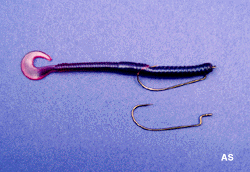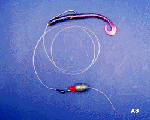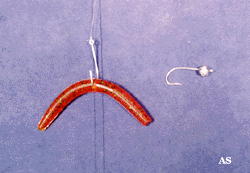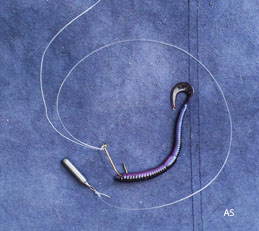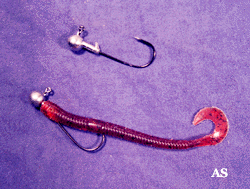
Soft Plastic Worms For Largemouth Bass Fishing
and How to Rig Them
Soft Plastic Worms
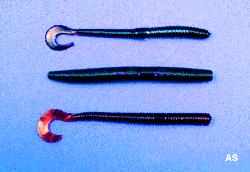
Top -- Renegade 4 inch Purple Twirl Tail Soft Plastic Worm
Middle -- Gary Yamamoto Senko
Bottom -- Berkley 4 inch Powerbait Pumpkinseed. Soft Plastic Worm
Follow this link to see: Gary Yamamoto Senko Worms on Amazon.com
Follow this link to see: Berkley Powerbait Worms on Amazon.com
Rubber Worms - Soft Plastic Worms
Rubber Worms, or more accurately Soft Plastic Worms, were first made by Nick Creme in 1949. The Scoundrels, as the first worms were called, with their life-like feel and durability, have gone on to become the most popular and effective artificial bait for catching largemouth bass. They now come in sizes from 3 inch to 16 inch and in all sorts of colors. Some are straight, and some have curly tails that flap and emit vibrations as they drift through the water. All catch fish, but most fisherman have their favorites. A common favorite is a 4 inch purple soft plastic worm as shown in the top photo above. The Gary Yamamoto soft plastic worm often just called a Senko, is a little fatter and thus heavier, and can be cast somewhat further with a spinning rod.
Texas Rig
There are numerous ways to rig a soft plastic worm. One of the most popular and effective ways is the Texas Rig. Texas rigging gives the lure weedless properties and adds no weight, other than the hook. Thus it can be cast into the water without causing too much commotion that might spook a fish. Then it can be left to gently drift down through the water with a natural wiggling action that bass can't resist.
To Texas Rig a soft plastic worm, start with an offset shank worm hook. Thread the hook through the worm's head to about a quarter of an inch behind the head, and out the bottom. Then turn it and thread it back, (about a hook length back), through the body of the worm so that its point just barely sticks through the top. As the hook point is pretty much concealed, the rig is mostly weedless.
As the Texas Rigged worm is lightweight, its use may be restricted to shallow or medium depth water, and to within achievable casting length. You can add weight to the Texas Rig by placing a bullet or egg sinker right up against the worm's head and securing it with something like a toothpick. However, in deeper water or for casting further a Carolina Rig, which provides some weight, may be better.
Carolina Rig
A Carolina Rig provides weight but still preserves most of the lure's action. To make a Carolina Rig, add about an 18 to 24 inch leader, then a barrel swivel. Above the barrel swivel add a bead, then a bullet or egg sinker. This rig can be cast further, and will more easily sink to the bottom in deeper water. The Texas Rigged worm is still attached and is somewhat buoyant. Thus, it can hover slightly above the bottom where moving water can give it some action.
Wacky Rig
To make a Wacky Rig, impale a hook through the middle of a soft plastic worm leaving the hook point exposed, as shown in the photo to the right.
The rig can be used anywhere, however it is not weedless, and works best in clear deep water and over structure on the bottom, if you can find it. The worm flutters enticingly as it drops to the bottom. Most hits occur during the fall.
If you have to add a little weight to make it fall, squeeze a split shot sinker on the shank of the hook right below the eye.
Some put an O-Ring around the worm and put the hook through the O-Ring. This is less damaging on the worm and it will last longer.
You can put a weight (like a nail) in one end of the worm. This converts it to a Neko rig and lets you present the worm vertically on the bottom.
Drop Shot Rig
Drop Shot Rig
Link to larger image
The Drop Shot Rig is becoming more popular with bass fishermen, including pros. That is because it gets good results.
The drop shot rig has a sinker on the bottom with a hook sticking out about 18 inches above the sinker.
To use a drop shot rig let the line run out until the sinker gets to the bottom. Then reel in to remove the slack. Then the soft plastic worm sticks out about 18 inches above the bottom, where the bass can readily see it. Once and a while jiggle your rod a little to give the worm some action.
Shaky Head Jig
Another good rig to use with rubber worms uses a Shaky Head Jig. The head of this jig provides a little weight so that you can cast it further and it will go down to the bottom. A barb on, or just below, the head holds the worm on so it wont slide off. Put about three eights of an inch of the top of the worm on the hook and over the barb, then attach the point of the hook through the bottom of the worm, making it weedless.
This jig works best if you use a floating worm, whose tail sticks up when the lure is on the bottom. Fish the jig slow, after it hits bottom shake your rod tip a little to make the worm's tail wiggle, then hop it along.
